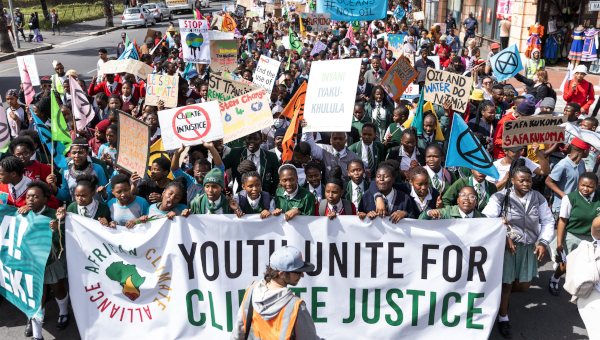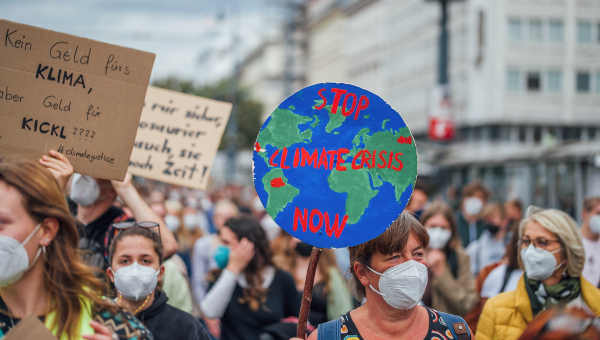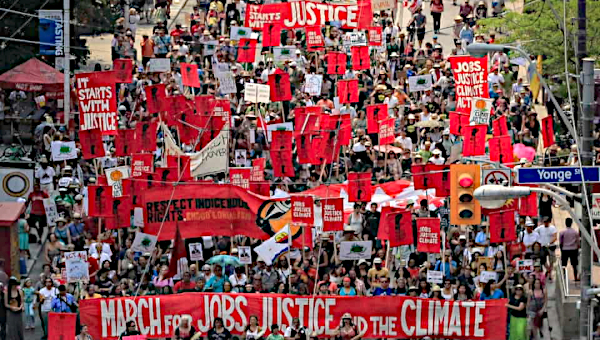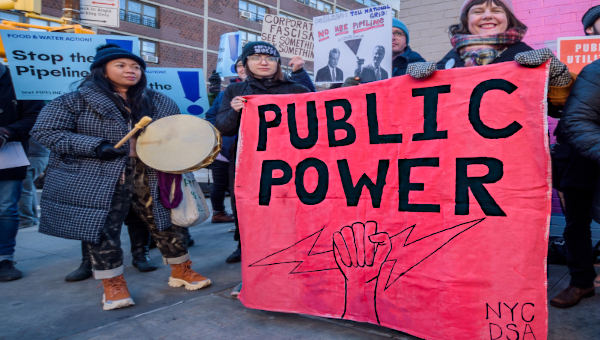Montreal 2005 Climate Change Conference
For persons in the Arctic watching permafrost and polar ice melt; in small island states watching the sea levels rise around them; in drought-filled regions watching another year’s crop fail; or in the path of yet another destructive hurricane watching their homes and livelihood get destroyed, the fact that climate change is happening is not a news story they have to read about to comprehend. It is their new reality that they must face everyday. What is news, ironically, is that climate change seems on the verge of permeating the collective conscience of everyone else. In a cover story on climate change released just a few weeks after hurricanes Katrina and Rita’s destruction, Newsweek magazine cited a poll where 67% of Americans thought global warming was to blame for the increased frequency and strength of hurricanes. The question remaining therefore is no longer when are states and firms going to wake up to the realities of climate change, but how committed are key actors and institutions to do what’s necessary to avoid the oncoming chaos?
A good indication of this is underway as we write with 10,000 delegates from 198 countries gathering in Montreal for the Eleventh Conference of the Parties (COP11) to the United Nations Framework Convention on Climate Change (UNFCCC.) The significance of this meeting is twofold: it is the first COP since the Kyoto Protocol came into force and thus will finalize all of the rules around the Protocol, including the controversial Clean Development Mechanism (CDM.) Secondly, as mandated by the Kyoto Protocol, this meeting will begin the discussion on the next commitment period as Kyoto is set to expire in 2012.
The Clean Development Mechanism
Back in 1997 when the Kyoto Protocol was being negotiated, the Brazilian delegation came forward with the idea of a Clean Development Fund whereby developed countries (called Annex 1 in the Protocol) would face heavy fines for missing their reductions targets, which would be put toward north-south clean technology transfer. However, the American delegation rejected this proposal in favour of a Clean Development Mechanism (CDM) that rejected fines and substituted emissions trading. Similar to their acid rain trading program, this scheme would allow Annex 1 (developed) countries to get credits against their own targets by investing in emissions reductions or sequestration projects in developing countries. The scheme effectively avoided forcing transnational polluters to pay for carbon pollution. When introduced the CDM proposal was rejected by the EU, the G78, and the vast majority of environmental organizations (ENGOs) as they worried it would fail to deliver real benefits in developing countries or any real reductions in developed countries. Yet the Americans made it very clear that they would not sign Kyoto without the CDM and so everyone finally agreed to it.
Now eight years later, the Americans of course have refused to ratify Kyoto, the Europeans have gotten over their initial opposition to trading and launched the EU Emissions Trading System (EUETS) in early 2004, and many ENGOs – such as the Climate Action Network (CAN) – now support trading. Yet the empirical evidence around all the flaws of the CDM keeps building up. In April 2005, the World Bank – a major supporter of the CDM through their Prototype Carbon Fund with its thirty-six projects and US$165 million budget – released their 2005 Carbon Market Trends study that affirmed the worse fears opponents to the CDM had back in Kyoto. Much like FDI patterns, the CDM is heavily concentrated in medium income countries, notably India, Brazil, and Chile. Emerging countries in the carbon market are China and Mexico. By contrast poorer countries, especially in Africa, have attracted very little investment, which even for the PCF raises “deep concerns about the overall equity of the distribution of the CDM market.” Secondly, for those countries who are getting the investments, the vast majority of emissions credits approved to date are concentrated around projects that capture and/or destroy other greenhouse gases like hydroflorocarbons or methane, which provide little benefits to local communities, but enormous returns on investments for project developers (due to their vastly increased potency compared to carbon dioxide, which is the currency of the carbon market.) Thus traditional energy efficiency and renewable energy projects, which were initially expected to represent the bulk of the CDM, now account for less than 5% of the market.
Canadian Hypocrisy
In recognizing the current state of the carbon market Stephane Dion – Canada’s Minister of the Environment and the current President of the COP as the host, pledged to “streamline” the process in order to bring more projects to the market more quickly and cheaply. This represents self-interest more than altruism as Canada’s GHG emissions are now 26% above 1990 levels rather than 6% below them as committed in Kyoto, meaning they will be purchasing huge amounts of CDM credits abroad. Yet rather than discuss ways to strengthen the very weaken sustainable development
provisions that countries set for their own projects, the “streamlining” process effectively weakens monitoring and oversight mechanisms (i.e. shorter approval timelines/public comment periods) and undermines the “additionality” requirement. For a project to have any legitimacy whatsoever – leaving aside the issues of environmental injustice, toxic hotspots, and the privatization of the air through the very act of trading property rights to pollute it – project developers must show that the project is additional to the status quo. In other words, if a project would occur anyway, there is no real reduction if a country or firm purchases those credits to maintain or increase its own pollution. Should this requirement be weakened, there would be no reason to believe this market could have even the most marginal impact on reducing global emissions. Yet there would be plenty of reasons to believe that those small set of countries and firms causing climate change will continue their profligate use of the atmosphere while many vulnerable communities continue to pay a heavy price.
Post-2012
Respecting the difficulties rich countries like Canada are having meeting even the most modest reductions targets under Kyoto, the sobering reality according to the scientific consensus is that the planet’s overall greenhouse gas (GHG) emissions must be reduced by 60-80% by 2050 in order to have a chance to avoid catastrophic and irreversible damage to the climate. Yet early indications are that the next treaty to cover the commitment period post-2012 could be even weaker Kyoto. The United States and Australia have already stated their refusal to discuss binding targets post-2012, and other heavy polluters like China and India still reject any firm targets as they claim such targets undermine their right to develop. In an overt attempt to weaken Kyoto’s legitimacy and undermine the post-2012 process, these countries, along with Japan and Korea in July 2005 launched a “New Asia-Pacific Partnership on Clean Development and Climate.” At its best this six-nation pact is little more than an energy trade agreement with no binding targets or emissions reductions of any kind. At its worst some analysts have argued that the Partnership is only an amalgamation of old projects, under a new name. Disturbingly, the “voluntary” nature of the Partnership is being shamelessly peddled as the model for Kyoto’s successor. Even previous Kyoto allies like Britain’s Tony Blair are now indicating their support for this approach and Paul Martin recently expressed his interest in joining the six-nation pact while in South Korea for the APEC Summit.
On the one hand some mainstream ENGOs have roundly rejected this voluntary approach in the next commitment period and have called for a binding 20-30% reduction below 1990 levels for developed countries. On the other hand some of the largest ENGOs, like Conservancy International and the Nature Conservancy openly support voluntarism as necessary tool and actively collaborate with some of the worst carbon polluters. The logic behind the collaborationist approach is that eventually the United States will set up its own GHG emissions trading scheme – as Senators John McCain and Joe Lieberman have attempted in the past – and the only way to get the Americans to join the next climate treaty is to create ways they can merge their carbon market with a global one. Although this may be possible, based on the experience thus far with emissions trading, there is little reason to believe that its future use will ensure climate health and justice.
Few ENGOs have broken rank to speak out against the market approach. A look around the conference halls provides at least one insight as to why. Of the hundreds of venue presenters not a single one so much as raises a probing question or even mentions the shortcomings of market based approaches. Further on, many of the ENGOs, multilateral agencies, and transnational firms presenters on hand are showcasing a bevy of neoliberal inspired, voluntary collaborations that span the gambit from encouraging students to support nuclear power and work in the nuclear industry (i.e., The North American Young Generation in Nuclear Group) to spreading the CDM gospel that “India is the destination for CDM projects” (i.e., the German development agency GTZ) to the International Petroleum Industry Environmental Conservation Association (IPIECA) call to inject carbon into deep earth wells. Yet no one is monitoring the plethora of voluntary, market inspired projects-such is the nature of voluntarism, and as a consequence no one has any clue how the multitude of neoliberal projects will help collectively tackle the unfolding climate crisis or not.
Grassroots Strategies and Resistance
In light of the sobering state of affairs at the climate talks, it is not surprising that the collective bar for successful conference outcomes have already been watered down to an agreement to keep negotiations open on the post-2012 framework. Ideally this will take place without U.S. involvement so they won’t have an opportunity to derail the talks as has been their objective in the past. Even without the Americans at the table no one seems to think that a market-free approach will be up for debate, especially with previous opponents to it such as Europe and mainstream ENGOs are now on board the trading express.
Thus space for critical debate is now both figuratively and literally at the margins of this conference. A Climate Justice Convergence Centre has been set up about four blocks from the UN conference centre where activists, community leader, and youth groups have created their own space complete with a photo exhibit, film series, and training workshops. Topics include climate change and forestry, impacts of oil extraction, the role of the World Bank, and an alternative people’s forum. The other key initiative underway in is a global march for climate change taking place in over forty countries on Saturday, December 3rd. The goal of the march, which will be largest in Montreal, is to put grassroots pressure on states to let them know their citizens demand a comprehensive and ambitious long-term framework to fight climate change.
While much of the discourse inside the UN climate talks leave much to be desired in the fight to prevent catastrophic climate change, one can still take much faith in the grassroots efforts and solidarity between affected communities to address this crisis. •
Resources
(1) Sign on to the ‘climate action now’ declaration at climateactionnetwork.ca.
(2) December 3: International Day of Action on Climate Change: The Toronto Rally will takes place on Saturday December 3 at Nathan Phillips Square
(100 Queen Street West), starting at 1 o’clock.
(3) From the Montreal Summit: check out – www.itsgettinghotinhere.org
for daily updates.
(4) For more resources on the struggles over global warming see:





